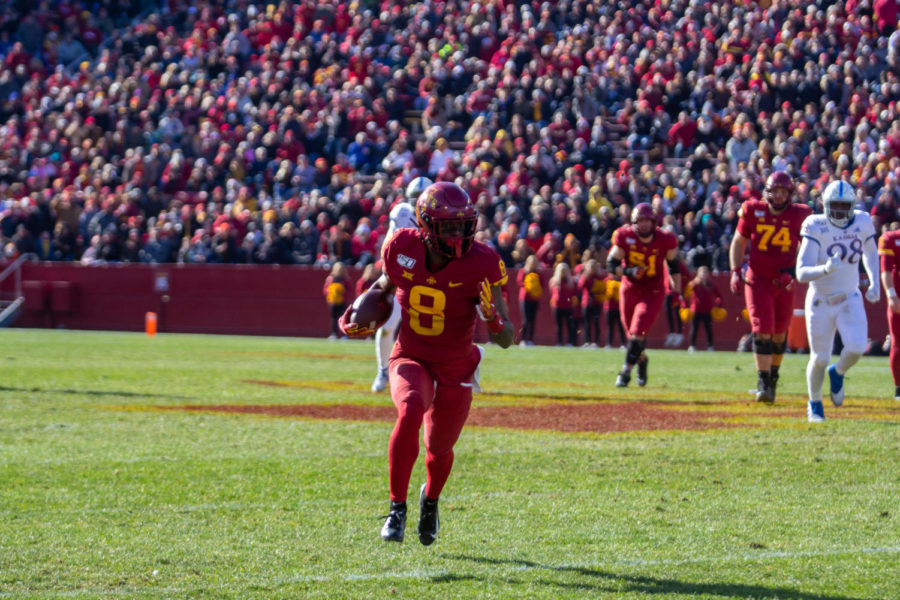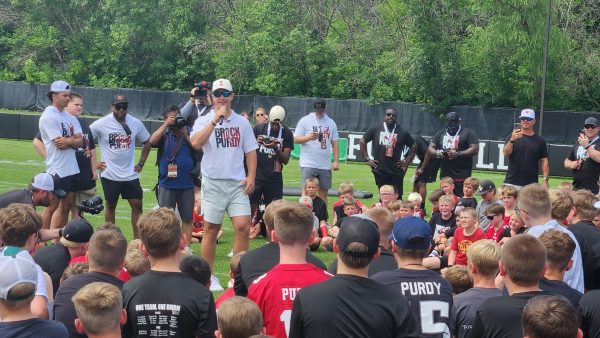Belinson: Iowa State’s potential offensive and special teams NFL prospects
April 19, 2020
The 2020 NFL Draft is nearly upon us, which means we are in the thick of mock draft and big boards season. Hundreds of college football prospects will be shuffled around and reordered by NFL evaluators and “draft experts” over the coming days, so why not join in on the madness?
Over the next two days, Sports Editor Zane Douglas and I will be looking at each side of the ball for Iowa State and evaluate the players we feel could become potential NFL prospects.
To be clear, I’m not saying any of these players will be drafted, rather, in this column I’ll just be evaluating their individual strengths and what NFL teams might see in them to be willing to spend a late-round draft pick or make a spot on a practice squad.
We’ll save who will and won’t get drafted from Iowa State for another column.
For now, let’s look at the top prospects for Iowa State on offense and special teams.
Julian Good-Jones (OL)
The anchor of Iowa State’s offensive line over the last four seasons has been Julian Good-Jones.
Now to be fair, Iowa State has never had the reputation, especially in the Matt Campbell era, of having stellar offensive line play, but Good-Jones has shown throughout his time in Ames that he is a steady force on the line.
Good-Jones has started most of his career at left tackle and center, two of the most important positions on the offensive line, and has had relative success at both. He has also played right tackle in his initial season as a Cyclone, showing NFL scouts that he is versatile and could be plugged in as a backup on either side of the line.
What might catch the eye of NFL evaluators is that Good-Jones stays on the field. He claimed an Iowa State record 49 consecutive starts in his career before missing the 2019 Camping World Bowl, but Good-Jones being able to consistently start as an offensive lineman over his four-year career can only be a positive in the eyes of potential teams.
Good-Jones last checked in at 6 feet, 5 inches, 308 pounds, which is right around the size of average NFL linemen and in the 2019 season, had no glaring issues when it came to size matchups with defensive linemen in the Big 12.
I would argue the most promising piece of anecdotal evidence that Good-Jones has going for himself is the fact that he kept A.J. Epenesa in check for most of the Cy-Hawk game on Sept. 14. The future first round pick finished with just one tackle and one quarterback hurry.
Obviously containing Epenesa was a group effort up front, but if you go back and watch Good-Jones matched up one on one with Epenesa, it looks like an even matchup to me.
I’m not saying Good-Jones can do that consistently game after game, but I would bet some teams could be evaluating Epenesa and while pouring over film from his 2019 season, might notice how Good-Jones had his way with him for much of the Cy-Hawk game and might overvalue that performance enough to give Good-Jones another look.
What made Good-Jones so effective against Epenesa in the Cy-Hawk game and against other worthy defensive linemen in the 2019 season was the fact that Iowa State ran an up-tempo offense, where Good-Jones never really had to fight for long stretches in pass protection, since Iowa State usually likes getting the ball out within three seconds.
His clear strength comes in blocking for the run, getting to the second level with ease and making big enough gaps for crafty running backs like David Montgomery or Breece Hall to make something happen.
Deshaunte Jones (WR)
As I’m sure you have heard by now, the 2020 NFL Draft is loaded with high-skill wide receivers, which some have argued could be the best draft for wide receivers in recent memory.
That doesn’t bode well for Deshaunte Jones and his potential of making it on an NFL roster, but there are some unique skills and characteristics that could make Jones a valuable late-round or practice squad piece to an NFL team.
The first thing to get out of the way is that Jones is very undersized for his position, standing at 5 feet, 10 inches and 180 pounds — not exactly the biggest receiver on the board. But in his case, not being the biggest receiver in the room could be a benefit to Jones. I mean, it clearly worked for him as a Cyclone.
Jones lined up most of his career as a Cyclone in the slot, running crossing routes and quick slants to let his open field playmaking go on autopilot the rest of the way for Iowa State.
Jones ended his career in Ames with the second most receptions in Iowa State history (184) and keep in mind that was with about five different quarterbacks.
That consistency in his receptions as well as his yardage with so many different types of quarterbacks could show an NFL team that Jones may not be Hakeem Butler or Allen Lazard, yet he still produced in short passes and was seen as a trusted target in varying types of offenses.
If an NFL team needed a receiver to run short yardage plays and quick routes underneath, Jones could be that guy. But looking at the amount of talent in the draft, that’s a very specific skillset that might not be enough to catch the eyes of scouts.
La’Michael Pettway (WR)
You can pretty much ditto what I said about the loaded NFL Draft class of receivers, because the same holds true for La’Michael Pettway.
At 6 feet, 2 inches and 223 pounds, Pettway fits the mold of an NFL wide receiver more than Jones, but a bigger frame won’t put Pettway in the category of any of the top receivers who have done what Pettway can do for longer periods of time and with higher levels of production.
Pettway could find himself on a practice squad based on his big frame, with some teams potentially seeing him being able to win one-on-one battles in the end-zone as a “go up and get it” type of receiver, but in today’s NFL, those types of players are basically extinct. Wide receivers in the NFL are asked to be great route runners, strong and fast all at the same time. Pettway has shown the ability to maybe become a practice squad redzone threat, but that is about all I see from him at the NFL level.
Pettway didn’t display an ability to blow by defensive backs and found most of his touchdowns and big yardage plays in short field passes that he would turn into longer plays with his ability to shake smaller defenders off.
Pettway was one of Purdy’s trusted targets in 2019, with the Arkansas transfer grabbing six touchdowns in his senior season.
Steve Wirtel (LS)
As strange as it is to say, Steve Wirtel, the former Iowa State long snapper, has the best odds of anyone on this list to get drafted and even those odds are incredibly low.
Wirtel was the only player from Iowa State who received an invite to the NFL Combine back in late February and was one of only two long snappers in the country to receive an invite.
As I wrote about in my story detailing Wirtel’s preparation for the NFL Draft, long snappers have been selected in the last five drafts, but history doesn’t always repeat itself, especially with a position as niche as long snapper.
Wirtel has been valued as one of the best long snappers in the country, especially in his final season as a Cyclone. Wirtel was a finalist for the Patrick Mannelly Award, given to the nation’s best collegiate long snapper.
He started all four years at Iowa State at long snapper, providing stability for an Iowa State special teams unit that was anything but stable in his four years in Ames.
Wirtel’s athletic ability was on full display at the combine, setting an NFL Combine record with his 4.76 40-yard dash time, the fastest time by a long snapper on combine history. He also put up 19 reps on the bench press.
Perhaps his unique athletic ability for his position and four year starting experience will be enough to have a team throw a late-round flyer on a position they could shore up for the next 10 years.

















